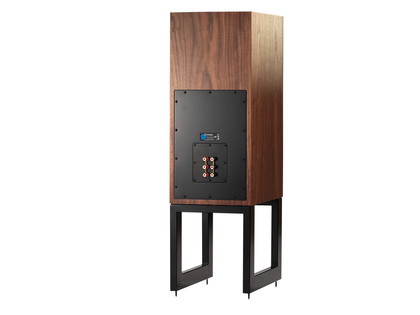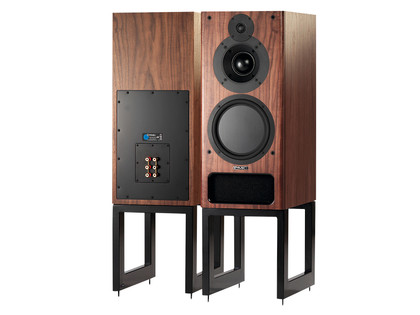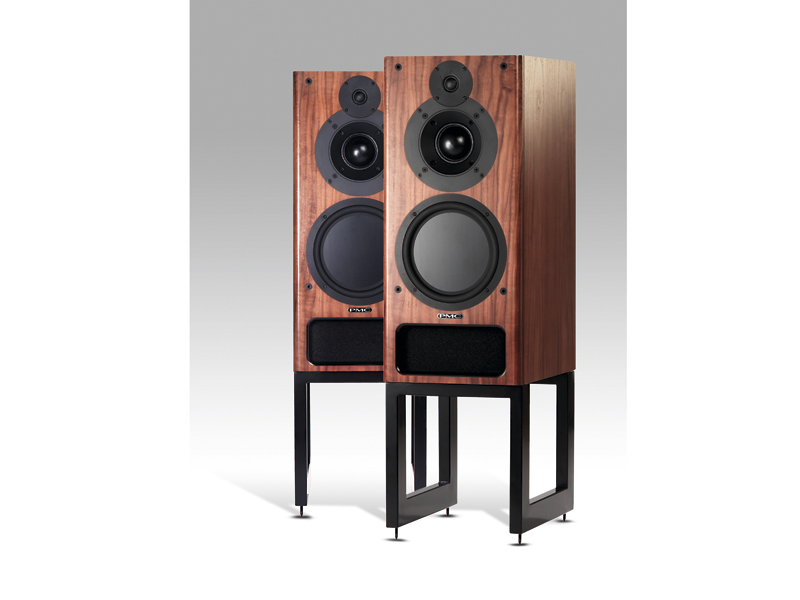TechRadar Verdict
This large standmount might look unfashionable, but it delivers top class sound quality at a realistic price. A genuine monitor, it delivers good neutrality, fine imaging and massive headroom with exceptional dynamic grip and expression
Pros
- +
Superb grip
- +
Dynamic expression
- +
Ample, clean bass
- +
Sweet, open top end
Cons
- -
The shape is unfashionably chunky
- -
Sound is a shade bright and lacking some warmth
- -
Monitors don't necessarily flatter the music
Why you can trust TechRadar
Standmounts, especially large ones like these PMC IB2i's, are certainly unfashionable these days, not to mention somewhat nostalgia-inducing: we're reminded of 1970s milestones like the Spendor BC3 and Linn Isobarik.
Slim floorstanders might be today's style icons, but the IB2i's, like those earlier classics, has an attractively chunky purposefulness. It comes with a simple tubular steel frame stand (fixed by beads of Blu-Tack).
This fixes floor-spikes securely and lifts the base of the speaker some 35cm off the floor, helping the bass propagate in a properly spherical manner.
The 250mm bass driver, designed by PMC but actually built by British bass driver specialist Volt Loudspeakers, has a flat 190mm diameter diaphragm and a stiff rubber roll surround.
Besides its massive magnet, PMC's own soft fabric, 75mm dome midrange driver is mounted on a large frame and inset behind a shallow 'waveguide', distinguishing it from the 'domestic' version.
The new 27mm soft fabric-dome tweeter was recently developed in collaboration with Norwegian specialist SEAS, which also makes it for PMC.
To maintain phase coherence, PMC uses steep 24dB/octave multi-element crossover networks. These are fed from three pairs of multi-way socket/binder terminals, each individually bolted through an alloy panel, which in turn is fixed to a much larger panel that occupies about half of the back panel, accommodating the complex crossover network proper.

The enclosure comes nicely decorated in a dark American walnut real-wood veneer. All drivers are flush-mounted, with the Detail front vertical edges nicely rounded. A hefty, full-height MDF-frame grille is supplied, but is probably better left unused.
Bass loading is accomplished by PMC's traditional 'advanced transmission line' (ATL). This technique is not that dissimilar to reflex or tuned column loading, but its proponents claim it has its own unique advantages. Certainly the partitions forming the folded line considerable stiffen the sides (though not the top, base or back).
Sound quality
Auditioning was carried out in a heavily furnished and somewhat irregular 4.4x2.6x5.5m (WxHxD) room. The speakers were 2.2m apart with their backs 0.6m from the nearest wall.
Most of the listening was done on a system with a Naim CDS 3/555PS CD player; a modified hybrid Rega/Linn Sondek LP12/Rega RB1000 tonearm/ Soundsmith Strain Gauge cartridge vinyl player; and a Magnum Dynalab MD 106T tuner.
Amplification included Naim NAC552 and XTC PRE-1 preamps, Naim NAP500 and MSB M200 Platinum power amps. Cables were from Chord Company, Vertex AQ, Phonosophie, Synergistic Research and Naim, while equipment supports included Mana, Vertex AQ, Naim and Townshend types.
Single wiring was used between amplifier and speakers, the speaker terminals joined by Vertex AQ mechanical damping links in place of the supplied brass rods.
Although fundamentally quite neutral, the mild balance anomalies are audible as a slight lack of warmth, leaving cellos and male voices a little short of richness but, in virtually every other respect, this is an exceptional loudspeaker.
The bass excess hardly ever seems intrusive, probably because it's unusually clean and well-timed: indeed it's actually rather welcome in adding extra weight and scale to the proceedings. The enclosure top and back feel quite 'live' when music is playing and, therefore, probably limit the overall dynamic range and low-level resolution somewhat.
It still remains essentially even-handed, however, with excellent time-coherence and good dynamic expression, especially through the midband. It can also go astonishingly loud with fine control and plenty of headroom.

DRIVEN: The PMC's rather special drive units are on show here, with the large transmission line exit close to the bass driver
It is a genuine monitor, confirmed by the ease with which it is possible to identify even subtle changes made 'upstream' amongst the system components. We're not certain whether it's possible to describe any loudspeaker as 'all things to all men', but the IB2i comes damn close.
It might not deliver the fastest or most dynamic sounds around and it might not offer the ultimate in transparency and image depth. But it gets close enough to all these goals and does so with the sort of solid overall neutrality and stereo imaging, something that other designs which are more extreme in one or other respect often fail to achieve.
The IB2i is not a cheap loudspeaker, but there are many far more costly models out there in today's marketplace. While these 'high-end' speakers may well offer a little extra refinement in one direction or another, we're not convinced that these refinements necessarily justify the sometimes exorbitant price tags.
Since this PMC is primarily aimed at a professional studio sector where fancy price tags are simply not tolerated, the IB2i is a top-class hi-fi speaker at a not unreasonable price.
Follow TechRadar Reviews on Twitter: http://twitter.com/techradarreview
